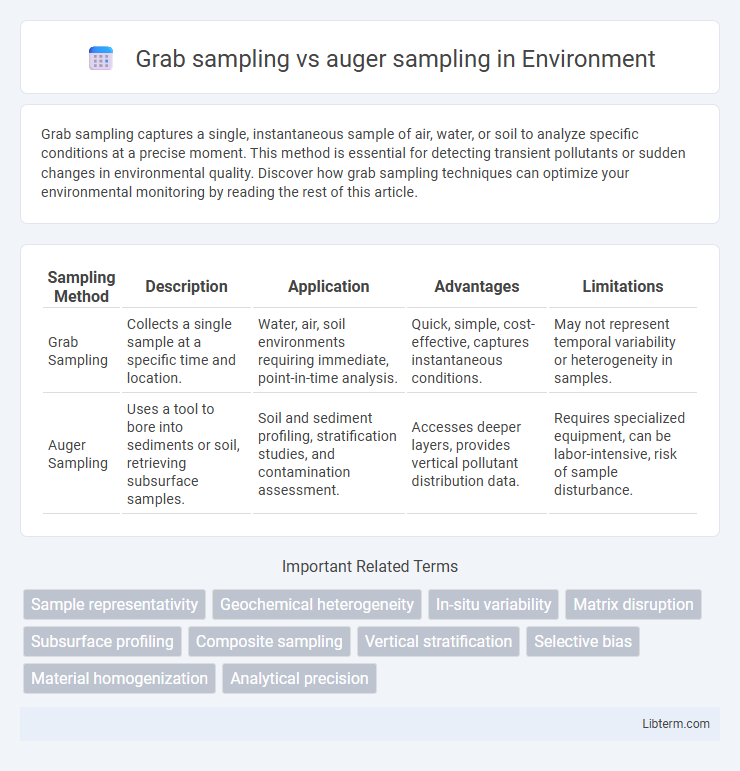Grab sampling captures a single, instantaneous sample of air, water, or soil to analyze specific conditions at a precise moment. This method is essential for detecting transient pollutants or sudden changes in environmental quality. Discover how grab sampling techniques can optimize your environmental monitoring by reading the rest of this article.
Table of Comparison
| Sampling Method | Description | Application | Advantages | Limitations |
|---|---|---|---|---|
| Grab Sampling | Collects a single sample at a specific time and location. | Water, air, soil environments requiring immediate, point-in-time analysis. | Quick, simple, cost-effective, captures instantaneous conditions. | May not represent temporal variability or heterogeneity in samples. |
| Auger Sampling | Uses a tool to bore into sediments or soil, retrieving subsurface samples. | Soil and sediment profiling, stratification studies, and contamination assessment. | Accesses deeper layers, provides vertical pollutant distribution data. | Requires specialized equipment, can be labor-intensive, risk of sample disturbance. |
Introduction to Grab Sampling and Auger Sampling
Grab sampling involves collecting a small, instantaneous sample from a larger bulk material to quickly analyze its properties, commonly used in industries like mining and environmental testing for preliminary assessments. Auger sampling, in contrast, uses a helical screw device to extract continuous samples from soil or granular materials, providing more representative data over a specific depth or volume. Both methods serve different purposes in material analysis, with grab sampling offering rapid results and auger sampling delivering detailed stratified information.
Definition of Grab Sampling
Grab sampling involves collecting a single, instantaneous sample from a specific location or point in a bulk material flow, representing the material's composition at that moment without mixing or averaging over time. This method contrasts with auger sampling, which uses a mechanical device to penetrate and collect subsamples from within a bulk material, providing a more representative sample by integrating material from different depths or locations. Grab sampling is often used for quick, preliminary analysis where immediate sample results are needed, despite potential variability.
Definition of Auger Sampling
Auger sampling involves extracting soil or sediment samples by boring into the ground with a helical screw called an auger, allowing for the collection of material from specific depths. This method provides a continuous profile of subsurface materials, making it useful for detailed geological or environmental analysis. Unlike grab sampling, which collects surface samples without depth control, auger sampling offers more precise vertical stratification data.
Key Differences Between Grab and Auger Sampling
Grab sampling collects surface material at a single point to quickly assess immediate composition, whereas auger sampling extracts subsurface samples by drilling vertically to capture stratified layers. Grab samples provide a snapshot of the surface environment ideal for immediate contamination or nutrient analysis, while auger samples offer detailed vertical profiles essential for geological or soil contamination studies. The precision of auger sampling in depth control contrasts with the simplicity and speed of grab sampling, influencing the choice based on the investigation's scope and required data accuracy.
Advantages of Grab Sampling
Grab sampling offers the advantage of rapid collection, allowing for immediate analysis of surface materials without the need for specialized equipment. This method provides a representative snapshot of the sample area, making it ideal for preliminary site assessment and quick decision-making. Compared to auger sampling, grab sampling minimizes contamination risks and reduces operational costs by eliminating drilling or excavation processes.
Advantages of Auger Sampling
Auger sampling offers precise subsurface material collection by penetrating deeper than grab sampling, allowing for a more representative sample profile of soil or sediment layers. This method reduces surface contamination and variability, enhancing the accuracy of geological or environmental assessments. Auger sampling is especially advantageous in identifying stratified deposits and obtaining consistent samples in cohesive or compacted materials.
Limitations of Grab Sampling
Grab sampling often provides an unrepresentative snapshot because it collects material from only one location at a single point in time, which limits its ability to reflect the overall variability of the sampled bulk material. This method can lead to inaccurate analysis, especially in heterogeneous or stratified materials where particles vary significantly in size, composition, or distribution. Consequently, grab sampling poses a high risk of sampling bias and fails to meet the requirements for statistical reliability in quality control or compositional studies compared to the more consistent auger sampling technique.
Limitations of Auger Sampling
Auger sampling faces limitations such as restricted depth penetration, making it unsuitable for deep soil or sediment analysis compared to grab sampling. It often provides less representative samples due to potential contamination and soil disturbance during the augering process. Auger sampling also struggles with coarse, gravelly, or compacted materials, reducing the accuracy and reliability of the collected data.
Applications of Grab and Auger Sampling in Various Industries
Grab sampling is widely used in environmental monitoring, wastewater treatment, and air quality analysis to provide instantaneous, representative samples of liquids or gases. Auger sampling is essential in agriculture and mining industries for collecting soil or sediment samples, enabling precise analysis of nutrient content or mineral composition. Both methods support quality control and compliance by facilitating accurate assessment of heterogeneous materials across diverse industrial applications.
Choosing the Right Sampling Method for Your Project
Choosing the right sampling method depends on the material characteristics and the accuracy requirements of your project. Grab sampling provides a quick, spot-check of a small portion, suitable for homogeneous materials or preliminary analysis, while auger sampling offers more representative samples by extracting material from a controlled depth, ideal for soils or sediments with variable composition. Evaluating the homogeneity, sample application, and budget constraints ensures optimal sample integrity and data reliability.
Grab sampling Infographic

 libterm.com
libterm.com